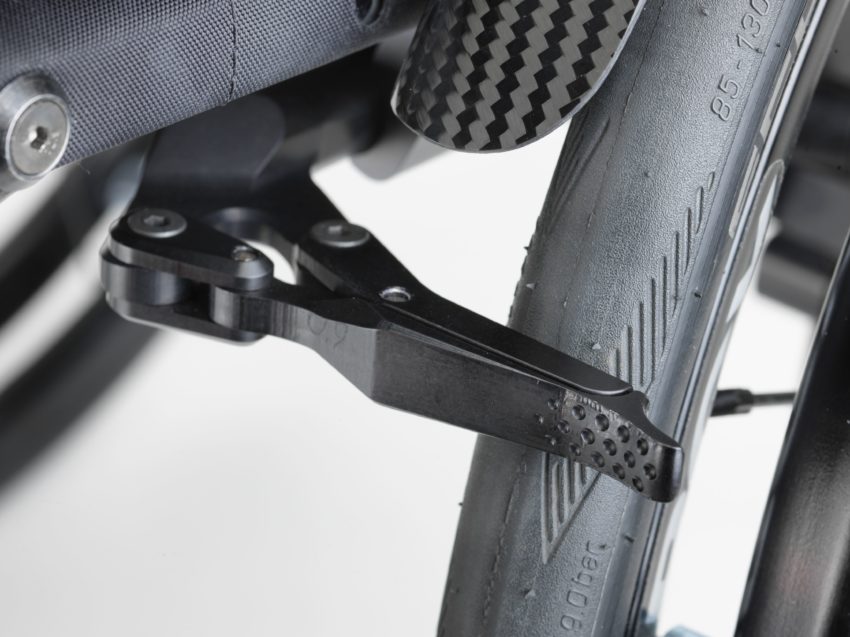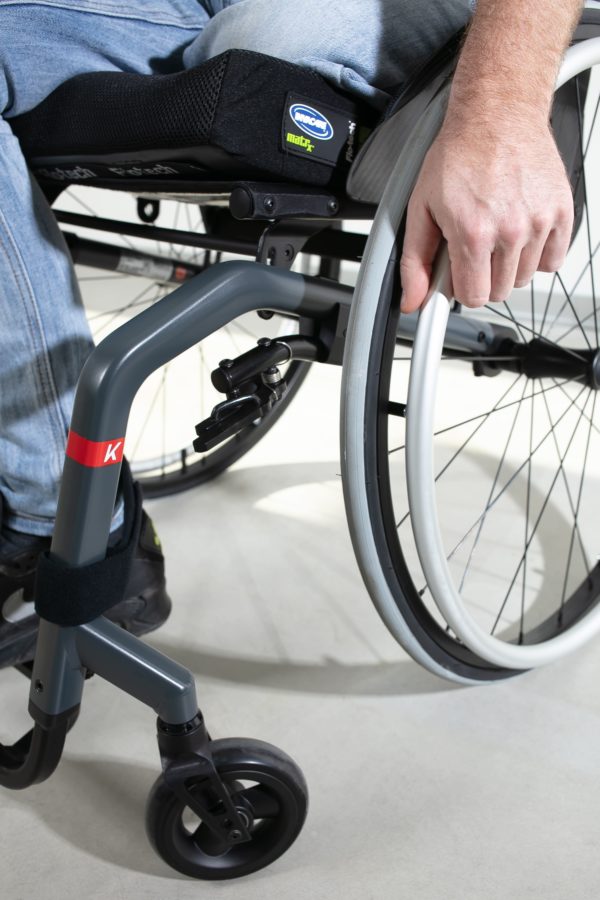Wheelchair Brakes: Maintenance and Adjustments

Your wheelchair’s brakes hold your wheelchair stationary and keep you safe, but do you know how to maintain and adjust your wheelchair brakes? Do you know how to spot when it is time to replace them? This article will tell you everything you need to know about your wheelchair brakes and how to keep them in good condition so they can carry on supporting your independence.
What types of wheelchair brakes are there?
There are several types of brakes that wheelchair users can choose from for their chair’s wheels.
Wheelchair brakes hold a wheelchair stationary, such as when the user is transferring to another piece of equipment. Wheelchair brakes are sometimes also called wheelchair wheel locks. Different locks are available to suit people with different degrees of strength and coordination, so test out a few before deciding to ensure you get one you can comfortably manage. So, what are the different wheelchair wheel locks or brakes?
Push/pull lock
Also known as a push-to-lock brake, push/pull locks are the most common type of wheel lock on manual wheelchairs. They are particularly common on wheelchairs for children, as they are easy to use. A push/pull lock works by a lever that is pulled or pushed to move a bar, so it is pressed against the chair’s tyre, keeping it steady and stationary. Occasionally you may come across a pull-to-lock brake, which is simply a push/pull lock in reverse. These have the advantage of giving you extra leverage when applying the brake, and you can use your body weight to push down on the brake to apply it.
Scissor lock
An alternative to a push/pull lock is a scissor lock. Scissor locks are attached to the frame of the wheelchair, with a bar that holds the brake against the wheel when it is locked in to place to hold the chair still. A scissor brake is designed to lock into place when you’re stationary. Once you’ve removed the brake, it sits clear of the tyre, which keeps your fingers away from the brake when you’re moving. Scissor locks are designed for more active wheelchair users who use the tyre and push rim to move themselves forward, and so may prove difficult to use for people with limited fine motor skills.
Wheel hub locks
Wheel hub locks are another option that have a concealed lever that locks the wheel via the wheel hub instead of the tyre. Extensions are also available for people who have less strength or limited reach, which can help you to operate your chair independently.
Should you use wheelchair brakes whilst in motion?
Wheelchair brakes are generally not designed to slow a wheelchair down when it is moving, although
some people do use them for this purpose. Different types of wheelchair have different braking mechanisms to slow a chair down while it is moving. For example, manual wheelchairs users can slow their wheelchairs down by using pressure from their hands on the wheel rims, while electric wheelchairs have controls to slow the chair down.
Power assist wheelchair brakes
The braking system of a power assist wheelchair are halfway between a manual chair with no braking assistance, and a power chair with brake controls. A power assist wheelchair looks similar to a manual one, but comes with clever technology installed, which automatically applies the brakes when the wheelchair user is going downhill. The light electronics detect the hand movement on the rims of a chair’s wheels, and slow or stop a chair according to what they sense.
Electric wheelchair brakes
Electric wheelchairs also have braking systems that allow the user to slow down and stop without requiring physical effort or careful manual dexterity. Usually operated by the user’s hand or head movements, brakes keep the user safe in a busy world and are a vital aspect of a modern wheelchair.
How do you maintain and adjust your wheelchair brakes?
Caring for and maintaining your wheelchair’s brakes is incredibly important. It will help ensure that they are safe, easy to use and last a long time. You should check your wheelchair’s brakes once per week. Here are some things to look out for when checking your brakes:
- Are the brakes looser or tighter than usual? If they’re too loose, they may not connect with the tyre firmly enough. They can be tightened by adjusting the screws that attach the brake’s bar to the wheelchair frame.
- Are your brakes not locking into place? It’s important to always adjust your brakes with fully inflated tyres. If you adjust your brakes with soft tyres, when you then inflate the tyre, the brake won’t lock into place.
- Are your brakes not connecting with the tyre? If your tyre has lost pressure the brakes may not connect properly. So, if your brakes aren’t locking into place, it is worth while checking if your tyres are fully inflated and adjusting them to fit the fully inflated tyres if necessary.
- Are the brakes stopping the chair from moving? If so, they might need some maintenance oil.
- Are the brakes in a position where they could cause harm or injury? For example, are they in a position where your thumb could catch on the brake when self-propelling? The brake’s position might need adjusting, or a different type of brake might be more suitable.
What should I do if I find that my wheelchair brakes need adjusting?
Always double check your chair’s manual when checking if your brakes and wheel locks are working well or when adjusting them. If they need to be tightened or loosened, the instructions will almost always be in the manual. The manuals for all of our wheelchairs are available on our website, just go to the product page to find the right manual. If you have a wheelchair from Invacare that is discontinued but you need a new copy of the manual for, then you should be able to find it via our discontinued products list. Simply click on the product you are looking for, such as the Küschall Advance manual wheelchair, and the scroll down the page to find the user manual downloads – available in several languages. Some products also have an additional Service Manual, which you can find in the same way.
Often, it is possible for the user of the chair or an assistant to do this themselves. Where possible, learning to maintain your own wheelchair is a valuable life skill that can help support your independence. Most wheelchairs come with a basic toolkit which can be used for rudimentary repairs.
However, you might well feel more comfortable leaving trickier adjustments to the experts. If you received your wheelchair from your local health authority, you should be able to make an appointment with them to have any necessary adjustments done. Alternatively, shops that specialise in mobility aids will likely have staff members who are trained in wheelchair maintenance who can help.
How do you put brakes on a wheelchair?
Every set of wheelchair brakes will come with instructions on how you assemble the brakes and attach them to the frame of your wheelchair. The positioning of the brakes will depend on:
- What type of wheelchair brakes they are.
- What type of wheelchair you have.
Not every type of wheelchair brake will be appropriate for every wheelchair. If you need replacements, it is a good idea to buy the same brakes that originally came with your wheelchair. If you find suitable alternative brakes, they will likely be attached to the same part of the frame as your old ones. This means they can be attached using the toolkit provided when originally receiving your wheelchair.
There are also many detailed ‘how to’ videos on YouTube that tell you how to attach brakes on different types of wheelchair (such as the Küschall range). These video guides are often easy to follow along with, especially if you’re unsure about how to make any changes or adjustments.
If you are still unsure about how to adjust or maintain your wheelchair’s brakes, it’s best to seek professional help. This could be through your local health authority, occupational therapist, or at a local mobility shop. Some bike shops may also be able to help – however, wheelchairs tend not to be their ultimate area of expertise, so be cautious if you do opt for this route.










